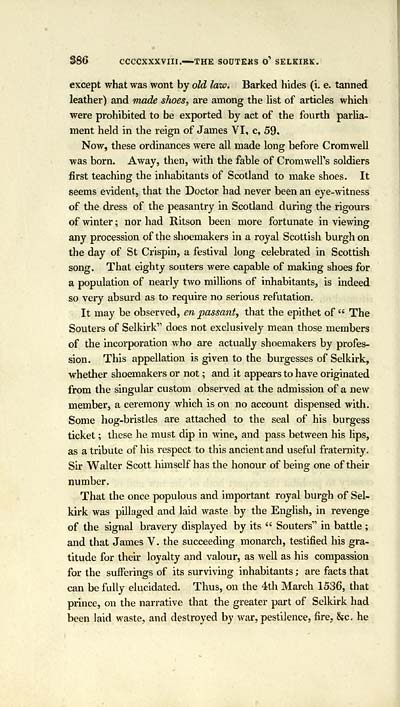Glen Collection of printed music > Printed music > Scots musical museum > Volume 5
(146) Page 386
Download files
Complete book:
Individual page:
Thumbnail gallery: Grid view | List view

CCCCXXXVIII.— THE SOUTKKS O SELKIRK.
except what was wont by old Iww. Barked hides (i. e. tanned
leather) and made shoes, are among the hst of articles which
were prohibited to be exported by act of the fourth parUa-
ment held in the reign of James VI, c, 59.
Now, these ordinances were all made long before Cromwell
was born. Away, then, with the fable of CromweU's soldiers
first teaching the inhabitants of Scotland to make shoes. It
seems evident, that the Doctor had never been an eye-witness
of the dress of the peasantry in Scotland during the rigours
of winter ; nor had Ritson been more fortunate in viewing
any procession of the shoemakers in a royal Scottish burgh on
the day of St Crispin, a festival long celebrated in Scottish
song. That eighty souters were capable of making shoes for
a population of nearly two millions of inhabitants, is indeed
so very absurd as to require no serious refutation.
It may be observed, en passant, that the epithet of " The
Souters of Selkirk'' does not exclusively mean those members
of the incorporation who are actually shoemakers by profes-
sion. This appellation is given to the burgesses of Selkirk,
whether shoemakers or not ; and it appears to have originated
from the singular custom observed at the admission of a new
member, a ceremony which is on no account dispensed with.
Some hog-bristles are attached to the seal of his burgess
ticket ; these he must dip in wine, and pass between his lips,
as a tribute of his respect to this ancient and useful fraternity.
Sir Walter Scott himself has the honour of being one of their
number.
That the once populous and important royal burgh of Sel-
kirk was pillaged and laid waste by the English, in revenge
of the signal bravery displayed by its " Souters" in battle ;
and that James V. the succeeding monarch, testified his gra-
titude for their loyalty and valour, as well as his compassion
for the sufferings of its surviving inhabitants ; are facts that
can be fully elucidated. Thus, on the 4th March 1536, that
prince, on the narrative that the greater part of Selkirk had
been laid waste, and destroyed by war, pestilence, fire, &c. he
except what was wont by old Iww. Barked hides (i. e. tanned
leather) and made shoes, are among the hst of articles which
were prohibited to be exported by act of the fourth parUa-
ment held in the reign of James VI, c, 59.
Now, these ordinances were all made long before Cromwell
was born. Away, then, with the fable of CromweU's soldiers
first teaching the inhabitants of Scotland to make shoes. It
seems evident, that the Doctor had never been an eye-witness
of the dress of the peasantry in Scotland during the rigours
of winter ; nor had Ritson been more fortunate in viewing
any procession of the shoemakers in a royal Scottish burgh on
the day of St Crispin, a festival long celebrated in Scottish
song. That eighty souters were capable of making shoes for
a population of nearly two millions of inhabitants, is indeed
so very absurd as to require no serious refutation.
It may be observed, en passant, that the epithet of " The
Souters of Selkirk'' does not exclusively mean those members
of the incorporation who are actually shoemakers by profes-
sion. This appellation is given to the burgesses of Selkirk,
whether shoemakers or not ; and it appears to have originated
from the singular custom observed at the admission of a new
member, a ceremony which is on no account dispensed with.
Some hog-bristles are attached to the seal of his burgess
ticket ; these he must dip in wine, and pass between his lips,
as a tribute of his respect to this ancient and useful fraternity.
Sir Walter Scott himself has the honour of being one of their
number.
That the once populous and important royal burgh of Sel-
kirk was pillaged and laid waste by the English, in revenge
of the signal bravery displayed by its " Souters" in battle ;
and that James V. the succeeding monarch, testified his gra-
titude for their loyalty and valour, as well as his compassion
for the sufferings of its surviving inhabitants ; are facts that
can be fully elucidated. Thus, on the 4th March 1536, that
prince, on the narrative that the greater part of Selkirk had
been laid waste, and destroyed by war, pestilence, fire, &c. he
Set display mode to: Large image | Transcription
Images and transcriptions on this page, including medium image downloads, may be used under the Creative Commons Attribution 4.0 International Licence unless otherwise stated. ![]()
| Special collections of printed music > Glen Collection of printed music > Printed music > Scots musical museum > Volume 5 > (146) Page 386 |
|---|
| Permanent URL | https://digital.nls.uk/87804362 |
|---|
| Description | Scottish songs and music of the 18th and early 19th centuries, including music for the Highland bagpipe. These are selected items from the collection of John Glen (1833 to 1904). Also includes a few manuscripts, some treatises, and other books on the subject. |
|---|
| Description | The Glen Collection and the Inglis Collection represent mainly 18th and 19th century Scottish music, including Scottish songs. The collections of Berlioz and Verdi collected by bibliographer Cecil Hopkinson contain contemporary and later editions of the works of the two composers Berlioz and Verdi. |
|---|

